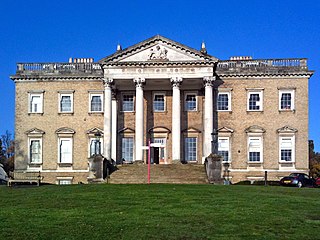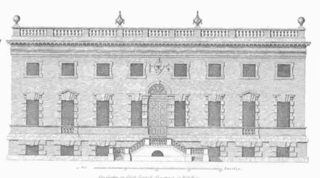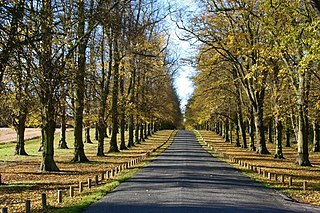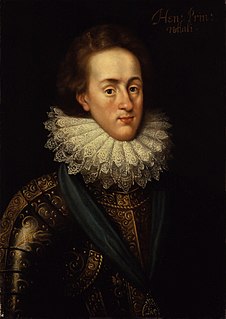
Chatsworth House is a stately home in Derbyshire, England, in the Derbyshire Dales 3.5 miles (5.6 km) northeast of Bakewell and 9 miles (14 km) west of Chesterfield. The seat of the Duke of Devonshire, it has been home to the Cavendish family since 1549.
Duke of Newcastle upon Tyne is a title that has been created three times. The related title Duke of Newcastle-under-Lyme has been created once to provide a slightly more remote special remainder. The title first was conferred in 1665 when William Cavendish was made Duke of Newcastle upon Tyne. He was a prominent Royalist commander in the Civil War. He had already been elevated as Viscount Mansfield in 1620, Baron Cavendish of Bolsover and Earl of Newcastle upon Tyne in 1621 and Marquess of the latter in 1643, and was created Earl of Ogle as main subsidiary title to the dukedom to be used as a courtesy style for his heir presumptive.

Claremont, also known historically as 'Clermont', is an 18th-century Palladian mansion less than a mile south of the centre of Esher in Surrey, England. The buildings are now occupied by Claremont Fan Court School, and its landscaped gardens are owned and managed by the National Trust. Claremont House is a Grade I listed building.

Colen Campbell was a pioneering Scottish architect and architectural writer, credited as a founder of the Georgian style. For most of his career, he resided in Italy and England.

Clumber Park is a country park in The Dukeries near Worksop in Nottinghamshire, England. The estate, which was the seat of the Pelham-Clintons, Dukes of Newcastle, was purchased by the National Trust in 1946. It is listed Grade I on the Register of Historic Parks and Gardens.

Haughton is a village in Staffordshire, England, approximately 4 miles outside and to the west of the county town of Stafford. It lies on the A518 between Stafford and Gnosall.

John Holles, 1st Duke of Newcastle-upon-Tyne , KG, PC was an English peer.

Belle Meade Plantation, located in Belle Meade, Tennessee, is a historic mansion that is now operated as a museum, together with outbuildings on its 30 acres of property. In the late 19th century, the plantation encompassed roughly 5,400 acres.

John Holles, 2nd Earl of Clare was an English nobleman.
Gilbert Holles, 3rd Earl of Clare was an English politician who sat in the House of Commons in 1660. He was styled Lord Haughton from 1637 until he succeeded to the title Earl of Clare in 1666.

Brindley is a village and civil parish in Cheshire, England. The village lies 3¾ miles to the west of Nantwich. The parish also includes the settlements of Brindley Lea, Ryders Bank and part of Radmore Green, with a total population of about 150. Nearby villages include Barbridge, Burland, Haughton and Faddiley.

Little Cressingham lies 2.5 miles (4.0 km) south east by road from Great Cressingham, 3 miles (4.8 km) west of Watton and 8 miles (13 km) south of Swaffham in the Breckland District of Norfolk. It covers an area of 11.90 km2 (4.59 sq mi) and had a population of 157 in 70 households at the 2001 census It is in the civil parish of Great Cressingham. The village is located on the edge of the Stanford Battle Area.

Duxbury Hall was a 19th-century country house in Duxbury Park estate in Duxbury Woods, Lancashire that has been demolished.

Sir Ralph Bourchier was an English landowner, administrator and politician.

Quernmore Park Hall is a grade II* listed Georgian country house which stands in a 20-acre estate in the village of Quernmore, part of the City of Lancaster district of England.

The Haughton River is a river located in North Queensland, Australia.

The Hall-Harding-McCampbell House is a historic mansion in Nashville, Tennessee, U.S..



















